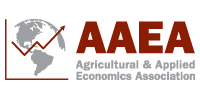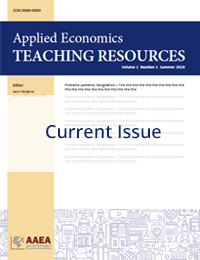Teaching and Educational Methods
FIRE Sustainability Analytics: An Innovative Approach to Engaging Undergraduate Students in Economics Research
Thanich Ruangmas(a) and Lars J. Olson(a)
(a)University of Maryland
JEL Codes: JEL Codes: A22, C8, Q2, Q5
Keywords: Course-based undergraduate research experience, data analytics, higher-order proficiencies, sustainability, teaching applied economics
First Published Online: March 10, 2025
Volume 6
View Full Article (PDF) | Request Teaching Notes/Supplemental Materials
Abstract
In response to the growing demand for undergraduate research experiences in economics, the FIRE Sustainability Analytics program offers a compelling solution. This program provides a course-based undergraduate research experience (CURE) in empirical environmental economics for first-year students at the University of Maryland (UMD). This paper outlines the program’s instructional design, highlights its role in advancing students’ higher-order economic proficiencies, discusses the institutional support behind the program, describes its research projects and their outcomes, and shares insights gained from nine years of program implementation.
References
American Statistical Association. 2014. “Curriculum Guidelines for Undergraduate Programs in Statistical Science.” Retrieved from https://www.amstat.org/docs/default-source/amstat-documents/edu-guidelines2014-11-15.pdf
Bangera, G., and S.E. Brownell. 2014. “Course-Based Undergraduate Research Experiences Can Make Scientific Research More Inclusive.” CBE—Life Sciences Education 13(4):602–606.
Bean, J.C. 2011. Engaging Ideas: The Professor’s Guide to Integrating Writing, Critical Thinking, and Active Learning in the Classroom. Hoboken NJ: Wiley.
Beichner, R. 2006. “Chapter 29. North Carolina State University: SCALE-UP.” In Learning Spaces, EDUCAUSE.
Deschênes, O., M. Greenstone, and J.S. Shapiro. 2017. “Defensive Investments and the Demand for Air Quality: Evidence from the NOx Budget Program.” American Economic Review 107(10):2958–2989.
Dewey, J. 1986. “Experience and Education.” The Educational Forum 50(3):241–252.
Fenn, A.J., D.K. Johnson, M.G. Smith, and J.L. Stimpert. 2010. “Doing Publishable Research with Undergraduate Students.” The Journal of Economic Education 41(3):259–274.
Gendron-Carrier, N., M. Gonzalez-Navarro, S. Polloni, and M.A. Turner. 2022. “Subways and Urban Air Pollution.” American Economic Journal: Applied Economics 14(1):164–196.
Gitter, S. 2021. “A Guide for Student-Led Undergraduate Research in Empirical Micro-Economics.” Journal of Economics Teaching 5(3):83–115.
Grimshaw, S.D. 2015. “A Framework for Infusing Authentic Data Experiences within Statistics Courses.” The American Statistician 69(4):307–314.
Hansen, W.L. 1986. “What Knowledge Is Most Worth Knowing for Economics Majors?” American Economic Review 76(2):149–153.
Hansen, W.L. 2001. “Expected Proficiencies for Undergraduate Economics Majors.” The Journal of Economic Education 32(3):231–242.
Heckman, J.J., and T. Kautz. 2012. “Hard Evidence on Soft Skills.” Labour Economics 19(4):451–464.
Henderson, A. 2018. “Leveraging the Power of Experiential Learning to Achieve Higher-Order Proficiencies.” The Journal of Economic Education 49(1):59–71.
Herrnstadt, E., A. Heyes, E. Muehlegger, and S. Saberian. 2021. “Air Pollution and Criminal Activity: Microgeographic Evidence from Chicago.” American Economic Journal: Applied Economics 13(4):70–100.
Hoyt, G.M., and K. McGoldrick. 2017. “Promoting Undergraduate Research in Economics.” American Economic Review 107(5):655–659.
Kennedy, B., R. Fry, and C. Funk. 2021. “6 Facts about America’s STEM Workforce and Those Training for It.” Retrieved from https://www.pewresearch.org/short-reads/2021/04/14/6-facts-about-americas-stem-workforce-and-those-training-for-it/
Klein, C.C. 2013. “Econometrics as a Capstone Course in Economics.” The Journal of Economic Education 44(3):268–276.
Kuh, G.D. 2008. “High-Impact Educational Practices.” Peer Review 10(4):30–31.
Light, C., M. Fegley, and N. Stamp. 2019. “Training Program for Research Educators of Sequential Course-Based Undergraduate Research Experiences.” FEMS Microbiology Letters 366(13).
Narum, J.L. 2013. A Guide: Planning for Assessing 21st Century Spaces for 21st Century Learners. Derwood MD: Learning Spaces Collaboratory.
National Research Council. 2012. Education for Life and Work: Developing Transferable Knowledge and Skills in the 21st Century. Washington, DC: The National Academies Press.
Russell, S.H., M.P. Hancock, and J. McCullough. 2007. “Benefits of Undergraduate Research Experiences.” Science 316(5824):548–549.
Salemi, M.K., and J.J. Siegfried. 1999. “The State of Economic Education.” American Economic Review 89(2):355–361.
Stamp, N. 2017. “Opinion: The Sweet Spot on the Teaching-Research Continuum.” The Scientist, September 2. https://www.the-scientist.com/opinion/opinion-the-sweet-spot-on-the-teaching-research-continuum-30976.
U.S. Environmental Protection Agency. 2022. “Clean Air Markets Program Data” [Data set]. Retrieved from https://campd.epa.gov/
“About,” University of Maryland Carillon Communities. Accessed March 12, 2024, https://carillon.umd.edu/about
“About,” University of Maryland College Park Scholars. Accessed March 12, 2024, https://scholars.umd.edu/about
“About Us,” University of Maryland Honors College. Accessed March 12, 2024, https://honors.umd.edu/about-us/
Vera, O. 2021. “You’ve Got Snail Mail: How Letters from STEM Professionals Are Changing Young Lives.” Retrieved from https://www.simonsfoundation.org/2021/12/15/youve-got-snail-mail-how-letters-from-stem-professionals-are-changing-young-lives/
Yamarik, S. 2007. “Does Cooperative Learning Improve Student Learning Outcomes?” The Journal of Economic Education 38(3):259–277.
Articles in this issue
Dare to Experiment: The Synergistic Relationship Between Undergraduate Research and Experimental Economics
Carl Nelson-Poteet , Lusi Xie, Kent D. Messer, and Leah H. Palm-Forster
Engaging Undergraduate Students in Research: From Cross-Discipline Programs to Published Articles
Gal Hochman and Yanhong Jin
FIRE Sustainability Analytics: An Innovative Approach to Engaging Undergraduate Students in Economics Research
Thanich Ruangmas and Lars J. Olson
Creating and Implementing Undergraduate Research Experiences: An Example for Analyzing the Size, Structure, and Performance of U.S. Food Manufacturing Industries
Yuliya V. Bolotova, Luke Juffer, Haylie Moore
Undergraduate Applied Microeconomic Research with Demographic and Health Surveys
Seth R. Gitter, Chris M. Boyd, and Raissa Abbasi
Undergraduate Research in the Andes: Overcoming Barriers to Developing-Country Farm-Household Focused Analysis
Jeffrey Alwang, Victor Barrera, Darrell Bosch, Susan Chen, Jorge A. Delgado, et al.


